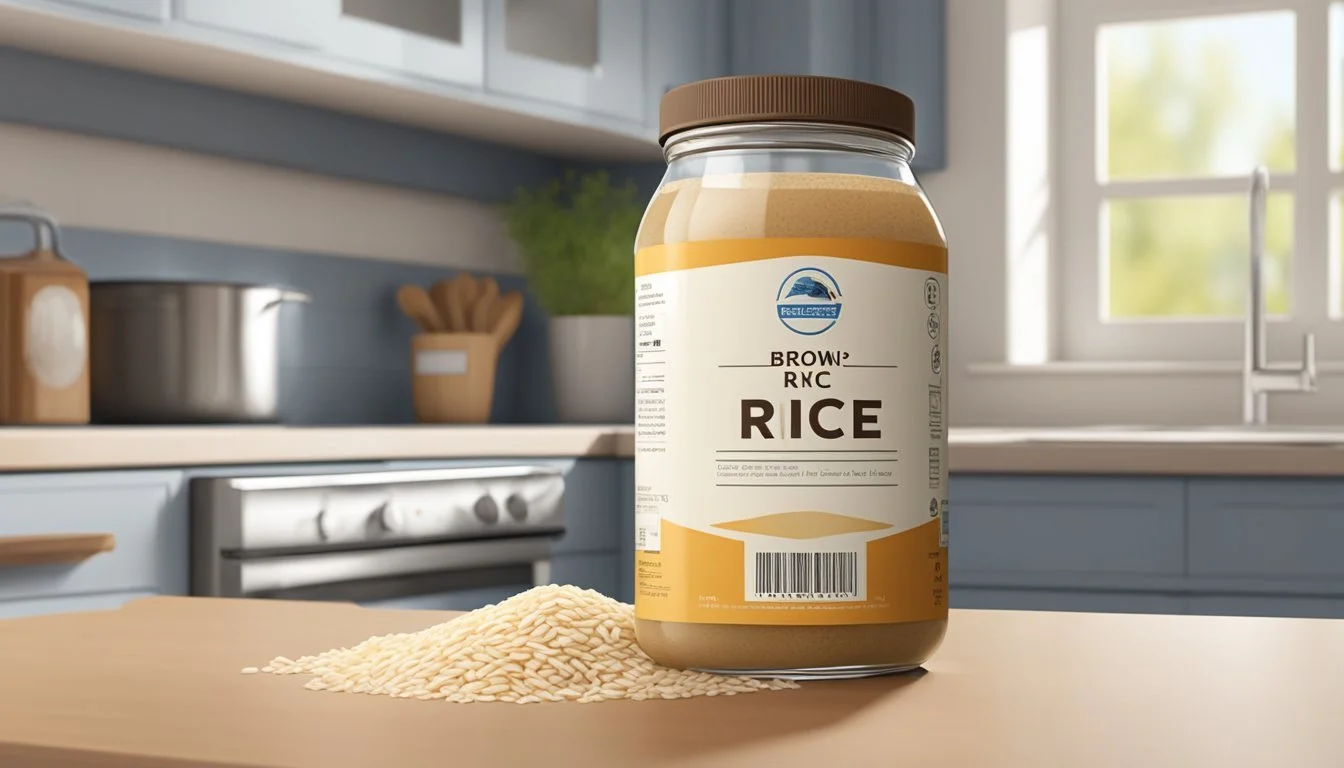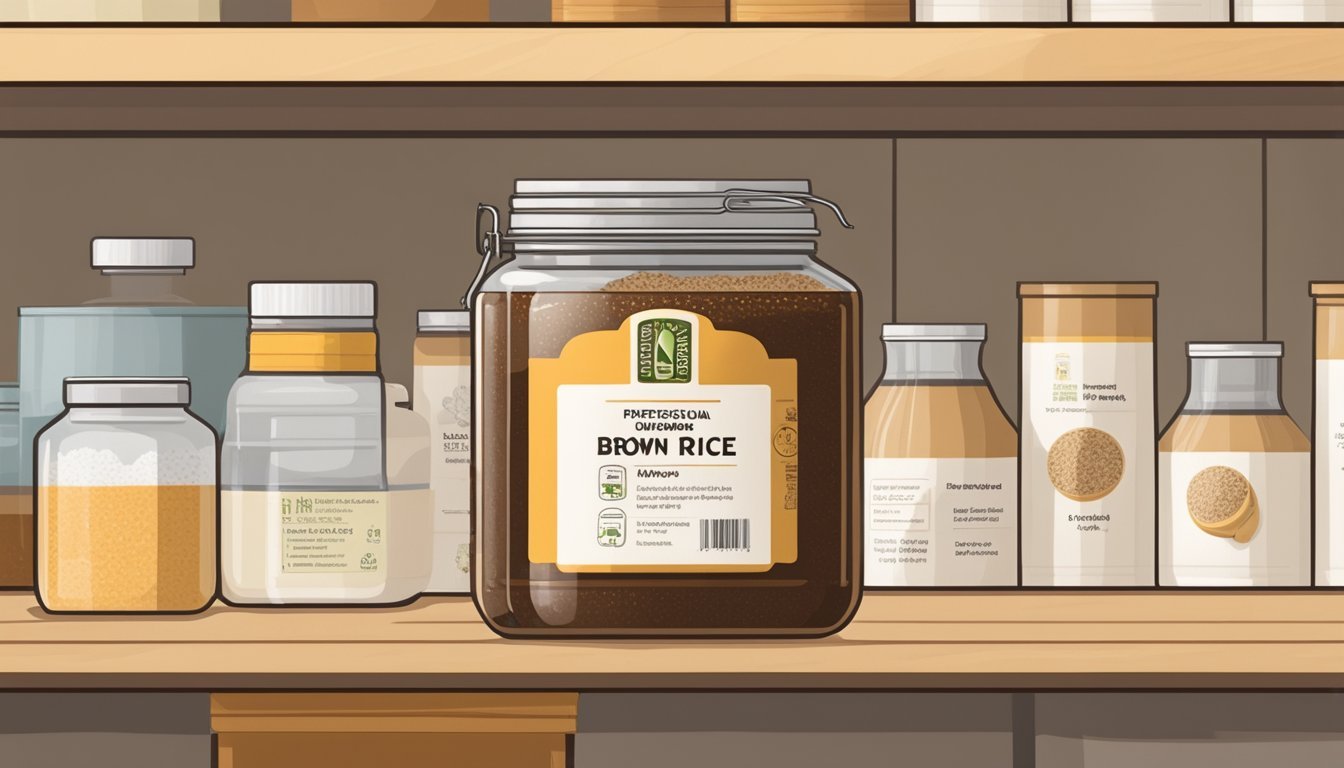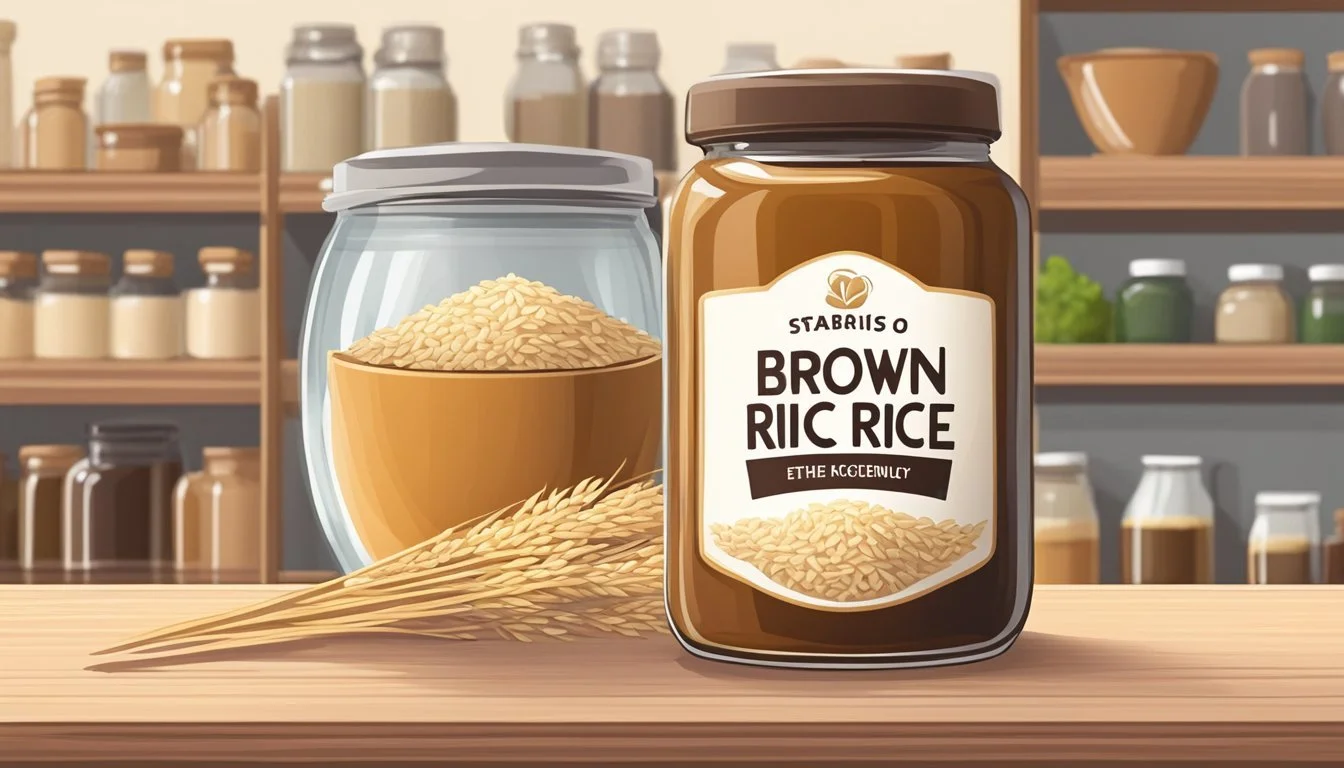Does Brown Rice Syrup Go Bad?
Storage Tips and Signs of Spoilage
Brown rice syrup, a popular natural sweetener, is favored for its mild flavor and versatility in various recipes. As a liquid sweetener, it offers an alternative to more processed sugars, making it a choice ingredient for those seeking a more natural option.
Brown rice syrup does go bad. When stored in a pantry under appropriate conditions, it generally has a shelf life of about one year. Proper storage is key to maintaining its quality and ensuring it remains safe for consumption.
Monitoring the shelf life of brown rice syrup is essential for both its taste and your health. Past its optimal period, the syrup might lose its flavor and consistency, and there is potential for degradation. Keep an eye on any changes and when in doubt, it's best to replace it.
What Is Brown Rice Syrup?
Brown rice syrup is a sweetener derived from brown rice. It involves cooking brown rice and exposing it to natural enzymes which convert the starches into smaller sugars like maltose, maltotriose, and a small amount of glucose.
This process results in a thick, amber-colored syrup known for its mild, nutty flavor.
It's commonly used in a variety of foods as a sweetener. Often, it is a preferred alternative to high-fructose corn syrup and white sugar, particularly in health-conscious and organic products.
Nutritional Aspects:
Gluten-Free: Safe for those with gluten sensitivity or celiac disease.
Vegan: Suitable for plant-based diets.
All-Natural: Made from natural ingredients with no artificial additives.
Common Names:
Rice Malt Syrup
Brown rice syrup has a high glycemic index (GI), meaning it can raise blood sugar levels rapidly. This is an important consideration for people monitoring their blood sugar.
While it is marketed as a more natural sweetener, brown rice syrup contains few essential nutrients. It has faint traces of minerals like zinc, manganese, and magnesium.
Uses:
Baking: Can be substituted in recipes that call for honey or corn syrup.
Snacks: Found in granola bars and other health snacks.
Beverages: Sometimes used in beverages for sweetening.
Despite its origins as a health-conscious sweetener, it is still sugar and should be consumed in moderation.
Nutritional Profile
Brown rice syrup is noted for its unique composition and nutritional attributes. Key points include its high glycemic index, significant caloric content, and its absence of certain nutrients like fructose.
Comparative Sweetness
Brown rice syrup is less sweet than table sugar. It primarily consists of maltotriose, maltose, and glucose. This blend produces a mild sweetness. While it scores very high on the glycemic index (98), meaning it leads to rapid spikes in blood sugar, its lower fructose content can be preferable for those avoiding fructose.
Caloric Content
Per 100 grams, brown rice syrup provides around 300 calories. This makes it a calorie-dense sweetener. In comparison to other sugars, this high caloric content means it should be consumed in moderation. High caloric sweeteners can contribute to weight gain if not managed properly. This aspect makes it important for those monitoring caloric intake to be cautious.
Vitamins and Minerals
Brown rice syrup lacks significant quantities of vitamins and minerals. Unlike whole brown rice, which contains fiber, vitamins like B vitamins, and minerals such as magnesium and calcium, the refining process for syrup strips away these nutrients. This absence means that while the syrup can add sweetness to foods, it does not contribute much to nutritional intake.
By focusing on these factors, users of brown rice syrup can better understand its nutritional profile and make informed choices about its use in their diets.
Culinary Uses
Brown rice syrup is a versatile sweetener appreciated in various culinary applications. It serves as an excellent substitute for refined sugars and enhances the sweetness of beverages, desserts, and baked goods with its unique flavor profile.
Substituting Sugars in Recipes
Brown rice syrup can replace traditional sugars in multiple recipes. This syrup offers a mild sweetness with a hint of nuttiness, making it suitable for sauces, marinades, and dressings. Use a 1:1 ratio when substituting brown rice syrup for honey or corn syrup. However, for granulated sugar, due to its liquid form, reduce other liquids in the recipe by about ¼ cup for every cup of brown rice syrup used to maintain consistency.
Beverage Sweetening
For those looking to sweeten beverages naturally, brown rice syrup is an ideal choice. It dissolves easily in hot drinks like coffee and tea, providing a consistent sweetness without altering the flavor profile significantly. Mix it into iced tea, lemonade, or cold-brew coffee for a smooth, less pronounced sweetness compared to table sugar. Its low fructose content makes it a preferred option for individuals seeking a healthier alternative to sucrose and fructose-laden sweeteners.
Creating Desserts
Brown rice syrup shines in dessert making, offering subtle caramel notes enhancing the overall flavor of treats. It’s particularly popular in recipes for homemade granola bars, cereals, and energy bites. These desserts benefit from the syrup’s sticky texture, which helps bind ingredients together effectively, maintaining the desired chewiness. Try using it in recipes for rice crispy treats or drizzling it over pancakes and waffles for added sweetness.
Use in Baked Goods
In baking, brown rice syrup provides moisture and extends the freshness of baked goods. Integrate it into cookies, muffins, and cakes to achieve a denser texture with a slightly chewy bite. When baking, keep in mind that brown rice syrup can increase browning, so lower the oven temperature by about 25°F to prevent overbaking. It pairs particularly well with whole grain flours, adding depth to homemade breads and pastries without an overwhelming sweetness.
Health Considerations
Brown rice syrup, a sweetener derived from brown rice, holds complex nuances regarding its health implications, particularly in blood sugar management and for those with celiac disease or gluten sensitivity.
Blood Sugar Impact
Brown rice syrup has a high glycemic index (GI) of 98, making it a significant factor in rapidly elevating blood sugar levels. Foods with a high GI are known to convert sugar into glucose quickly, which can lead to spikes in blood sugar.
For individuals with diabetes or insulin resistance, this can be problematic. They should monitor their intake carefully to avoid exacerbating their condition.
Unlike some other sweeteners, brown rice syrup does not contain fructose, which means it does not affect blood sugar the same way fructose-laden sweeteners do. However, the high GI means it can still be a concern for sugar-sensitive individuals. Arsenic contamination is another health consideration. Consumers should look for products certified to be low in arsenic to mitigate this risk.
Celiac and Gluten Sensitivity
Brown rice syrup is naturally gluten-free, making it a suitable option for individuals with celiac disease or gluten sensitivity. This sweetener is derived solely from brown rice, ensuring no gluten-containing ingredients are involved in its production.
Some brown rice syrup products may also be labeled organic, adding another layer of assurance for those seeking high-quality, minimally processed options.
It's also important to note that while brown rice syrup is gluten-free, it's always advisable to check for any possible cross-contamination. Some packaging may list gluten-free certification for additional peace of mind.
Individuals using brown rice syrup in infant formulas or other sensitive dietary needs should verify the absence of gluten and any potential contaminants by checking labels approved by the Food and Drug Administration (FDA).
Shelf Life and Storage
Brown rice syrup has a shelf life of about one year when stored under proper conditions. It is essential to keep it in an appropriate environment to maintain its quality and prevent spoilage.
Optimal Storage Conditions
Brown rice syrup should be stored in a cool, dark place away from direct sunlight, as exposure to heat and light can degrade its flavor and texture. A pantry or cupboard is ideal for maintaining its quality.
The container should be airtight to prevent contamination and keep moisture out. This helps to retain the syrup's optimal flavor and consistency.
Refrigeration vs. Pantry
Storing brown rice syrup in a pantry is generally sufficient if the environment is cool and dry. The typical room temperature in a kitchen pantry is suitable, provided it stays steady and does not fluctuate significantly.
Refrigeration can extend the shelf life further, making it an excellent option for those who do not use the syrup frequently. Place the container in the refrigerator with a tight seal to avoid moisture absorption and contamination.
Recognizing Spoilage
Spoilage signs include changes in color, texture, and odor. If brown rice syrup appears cloudy, has developed mold, or smells off, it is best to discard it.
Using clean utensils each time you scoop out the syrup helps prevent contamination. Look out for any separation or crystallization, which can indicate that the syrup is starting to degrade and may soon be unfit for consumption.
Keeping these points in mind ensures the syrup stays fresh and safe to consume for as long as possible.
Environmental and Ethical Considerations
Production of brown rice syrup can have various environmental and ethical implications. One major consideration is the choice of sourcing organic versus non-organic brown rice. Organic agriculture aims to minimize the use of synthetic chemicals and promote biodiversity, which can be more environmentally sustainable.
Another point to consider is the geographical source of the brown rice. Major producers include countries in Asia, the United States, and parts of Europe. The carbon footprint associated with the transportation of these products can vary significantly based on the distance to the final market.
Given that brown rice syrup is a plant-based sweetener, it aligns well with vegan and plant-based dietary practices. This makes it a suitable alternative to sweeteners like high-fructose corn syrup, which are often less environmentally friendly and more resource-intensive to produce.
The cultivation of rice, the primary ingredient, also has an impact. Rice paddies generate methane, a potent greenhouse gas. However, the organic brown rice syrup sector often employs more environmentally friendly farming practices to mitigate this issue.
Ethical considerations also extend to labor practices. Ensuring that the brown rice is sourced from farms that treat workers fairly and provide safe working conditions is crucial. Consumers may prefer brands that are transparent about their supply chain practices.
Ultimately, while brown rice syrup is a natural sweetener, its environmental and ethical impacts vary based on how and where it is produced. Opting for organic and sustainably sourced options can mitigate some of these concerns.
Alternatives to Brown Rice Syrup
There are numerous alternatives to brown rice syrup that can cater to different taste preferences and dietary needs. Suitable options include various natural sweeteners, many of which offer unique flavors and health benefits.
Other Natural Sweeteners
Honey is a popular substitute due to its rich flavor and natural origin. It is sweeter than brown rice syrup, so less is needed. Maple syrup offers a distinct taste and beneficial antioxidants.
Molasses provides a robust flavor, making it ideal for baking. Agave nectar is another option, favored for its lower glycemic index.
For a highly processed but easily available alternative, there are corn syrup and high-fructose corn syrup, which are often used in commercial products.
Balancing Taste and Health
When choosing a sweetener, balance between taste and health is crucial. Honey and maple syrup provide natural sweetness while offering vitamins and minerals.
Molasses stands out for its high iron, calcium, and magnesium content. Agave nectar offers a mild flavor and can be a good choice for those monitoring blood sugar levels.
Using these alternatives in moderation is key, as even natural sweeteners can impact health if overconsumed. Additionally, fruits like dates can be blended into syrups for a wholesome option that adds fiber and nutrients to recipes.








